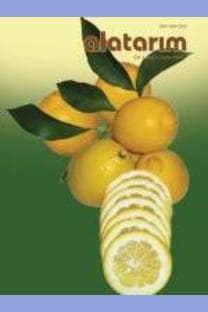Adana ili Feke ilçesinde bulunan sedir mantarı (Tricholoma anatolicum Doğan&Intini)’nın ekolojik isteklerinin belirlenmesi
iklim faktörleri, Türkiye, Adana, yetişme yeri faktörleri, kültür mantarı, ekoloji, bitki örtüsü
Determination of ecological requirements of cedar mushroom (Tricholoma anatolicum Doğan&Intini) in Feke-Adana
climatic factors, Turkey, Adana, site factors, mushrooms, ecology, cover crops,
___
- Akman, Y., 1990. İklim ve Biyoiklim. Palme Yayınları, Mühendislik Serisi:103, Ankara.
- Cherfas, J., 1991. Disapperaing Mushrooms: Another Mass Extinction. Science, 254:1458.
- Dayan, S., Ünlü, T., Sayılı, İ.S., 2008. Adana-Mansurlu Attepe Demir Yatağı’ nın Maden Jeolojisi,Jeoloji Mühendisliği Dergisi. Cilt:32, Sayı:2. Ankara.
- Hosford, D., Pilz, D., Molina, R., Amaranthus, M., 1997. Ecology and Management of the Commercially Harvested American Matsutake Mushroom. 68 pp. USDA, Forest Service, PNW Research Station, Portland, OR. PNW-GTR-412.
- Intini, M., Doğan, H.H., Riva, A., 2003. Tricholoma anatolicum spec. nov.: A New Member of the Matsutake Group. Micol. e Veget. Medit., 18(2):135-142.
- Kaji, H., Ueno, M., Ikebe T & Osajima, Y., 1992. Effects of Low O2 and Elevated CO2 Concentrations on The Quality of Matsutake Tricholoma matsutake (S. Ito et Imai) Sing. During Storage. Biosci. Biotech. Biochem. 57:363–366.
- Kantarcı, M.D., 1982. Akdeniz Bölgesinde Doğal Ağaç ve Çalı Türlerinin Yayılışı ile Bölgesel Yetişme Ortamı Özellikleri Arasındaki İlişkiler. İÜ Orman Fak. Yay. No: 330, İstanbul.
- Kawai, M., Ogawa, M., 1981. Some Approaches to The Cultivation of A Mycorrhizal Fungus, Tricholoma matsutake. Mushroom Science 11:869-883.
- Lefevre, C., Hall, I.R., 2001. In The Global Status of Truffle Cultivation. Proceedings of the Fifth International Congress on Hazelnut (556). In: Mehlenbacher, SA (ed.), Acta Hortic., pp.513-520.
- Olivier, J.M., 2000. Progress in The Cultivation of Truffles. In Mushroom Science Xv:Science and Cultivation of Edible Fungi (Vol. 2) Balkema, 937-942.
- Özgül, N., Metin, S., Dean, W.T., 1972. Doğu Toroslar’da Tufanbeyli İlçesi (Adana) Dolayının Alt Paleozoik Stratigrafisi ve Faunası, Maden Tetkik ve Arama Dergisi. Sayı:79, Sf. 9–17. Ankara.
- Redhead, S.A., 1997. The Pine Mushroom Industry in Canada and The United States: Why It Exists and Where It Is Going. In Chapela, I. H., Palm & M. E. (eds). Mycology in Sustainable Development: Expanding Concepts Vanishing Borders, pp. 15–54. Parkway Publishers, Boone, NC.
- Solak, M.H., Kalmış, E., Kalyoncu, F., 2007. Sedir Mantarı. İzmir.
- Türkoğlu, A., Kanlık, A., Gezer, K., 2007. Macrofungi of Çameli District (Denizli-Turkey). Turk J Bot 31, 551-557.
- Türkoğlu, A., Gezer, K., 2006. Hacer Ormanı (Kayseri)’nın Makrofungusları. Çev-Kor Ekoloji 15, 59, 43-48.
- Yeşil, Ö., Yıldız, A., 2004. Contributions to The Macrofungi Flora of Batman Province. FÜ Fen ve Mühendislik Bilimleri Dergisi, 16(1), 11-16.
- Yılmaz, T., 1996. Akdeniz Doğal Bitki Örtüsü. ÇÜ Ziraat Fak. Genel Yay. No:141, Yardımcı Ders Kitapları Yay. No: 13, Adana.
- Yun, W., Hall IR & Evans, L.A., 1997. Ectomycorrhizal Fungi with Edible Fruiting Bodies 1.Tricholoma matsutake and Related Fungi. Econ. Bot. 51: 311–327.
- ISSN: 1304-2653
- Başlangıç: 2015
- Yayıncı: Alata Bahçe Kültürleri Araştırma Enstitüsü
Hatay ve Adana illerinde kavun üretiminin sosyo-ekonomik açıdan değerlendirilmesi
Bazı nüseller tanjelo klonlarının meyve verim ve kalite özelliklerinin belirlenmesi
Bilge YILDIRIM, TURGUT YEŞİLOĞLU, MERAL İNCESU, Müge U. KAMİLOĞLU, Önder TUZCU
Anamur koşullarında örtüaltında yetiştirilen muzların beslenme durumlarının incelenmesi
HASAN PINAR, Cengiz TÜRKAY, CENAP YILMAZ, Mustafa BİRCAN, İtibar ÇAKIR, Bünyamin KOZAK, Sevgi PAYDAS
CELALETTİN DURAN, HATIRA TAŞKIN, Saadet BÜYÜKALACA
Organik ve konvansiyonel kayısı yetiştiriciliğinin meyve verim ve kalitesine
Salih ATAY, Sezai ŞAHİN, Kadir ÖZTÜRK, Bülent ÖZTÜRK, M. Naim DEMİRTAŞ
Çetin NACAR, Veysel ARAS, Nihal DENLİ, Davut KELEŞ
Bitkilerde mutasyonların tespiti için kullanılan moleküler yöntemler
